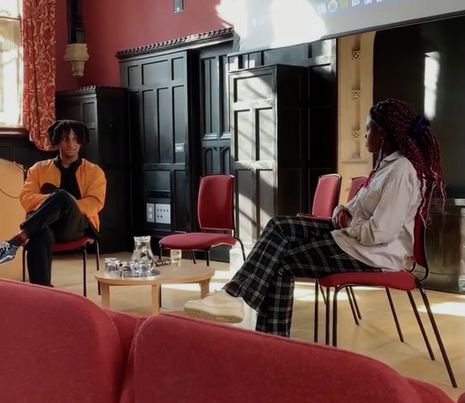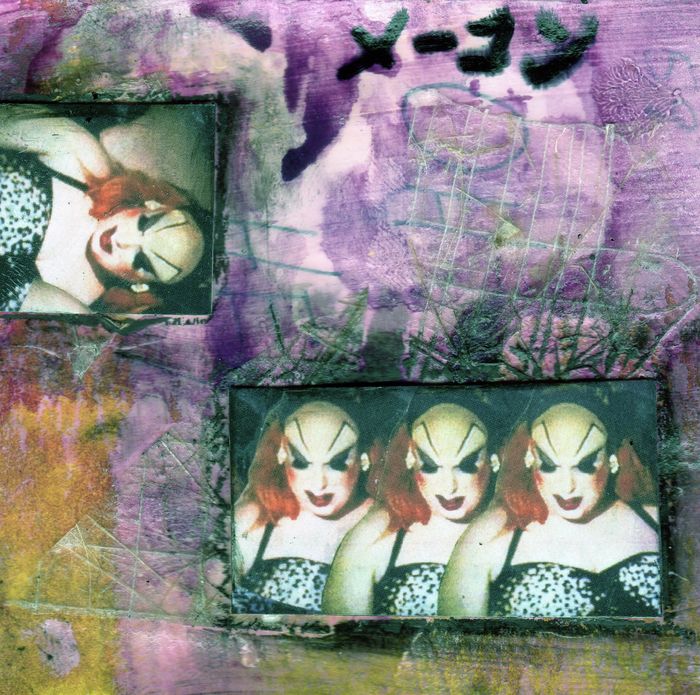This interview was set up as a collaborative event with Cambridge University Film Association, Cavendish Arts Science and BREAD Theatre and Film Company. The interview was led by Qawiiah Bisiriyu.
Content Note: This article contains brief discussion of police brutality and racism.
“Black theology lies somewhere between utopia and madness”, are the words in a bold white font that adorn the screen in front of me in the Old Divinity School, St. John’s College. Logan Ryland Dandridge experiments in his films with the visual aspect of text and typography, and as I sit with my ears filled with gospel music, my brain tasked with reading the flashing text, and my eyes focused on the archival footage of sports games, music videos, and political speeches, Dandridge achieves his aim of complicating and disrupting traditional narrative. He presents me and everyone else in the lecture theatre with a “cacophony of material” that requires us, above all, to bear witness to something.
“What is a film?” he asks. “How else can I fill the screen?” Dandridge’s work is full of shock and subversion: technological influence, overlayed and inter-spliced images, collage and superimposition, intermittent glitches and disparate sounds. Filling the screen with anything but cinematic tradition, the films that Dandridge shows us on this sunny afternoon trouble the ontology of filmmaking. “What actually constitutes a film?” he begs us to consider. Dandridge speaks of his films as if they are living, morphing, breathing entities. They are, naturally, dynamic with their moving images, but they are dynamical, too, in their existence and their meaning. Concerned deeply with the intersection of different forms of artistic and non-artistic media, during the two hours I spent enthralled by Dandridge, he used multiple metaphors to try and get at what a film is to him. “Sometimes, a filmmaker is like a composer”, he tells us. “Sometimes, we’re just trying to find the right combination of instruments.”
“Dandridge speaks of his films as if they are living, morphing, breathing entities”
This musical metaphor is particularly harmonious with Dandridge’s creative process: “Sometimes I will listen to a song, and I will just go from there. I like to work backwards, in a sense,” he describes. If the filmmaker is a composer of sorts, Dandridge’s conceptual reliance on music makes sense. Describing jobs held by his younger self, he talks to us about working in audio for ESPN during sports matches. “It wasn’t necessarily art, it wasn’t art at all”, he tells us. “I used to hold a giant disk to capture the sounds of the game.” From there, Dandridge details the technological journey that led him to play with sound, and makes music so central to this quasi-compositional creative process.

Though this approach might sound somewhat systematic and formulaic, Dandridge’s work practices are anything but. “Are you ever finished with a piece of work?”, asks Qawiiah Bisiriyu who leads the discussion. “F*** no,” say Dandridge through laughter. He sees his pieces as fundamentally works-in-progress, films which give birth to new ideas and other films, endlessly regenerating themselves. Dandridge currently holds a Cavendish Arts Science Fellowship at Girton College Cambridge, and he credits scientific thinking and physics as one of his many inspirations.
“I’m thinking about how physics can be used to reckon with the continuum of Black experience in the interest of more disruptive scientific and artistic interventions,” reads a quote from Dandridge on the Cambridge Physics Department website. Certainly these scientific and ontological anxieties shine through in Dandridge’s work: temporal and spatial uncertainty shape many of his short films, down to the uncertainty of the ‘film’ itself and what it means. “I want to try and breathe these anxieties and discoveries into the Black experience,” says Dandridge.
“In a way, Dandridge’s work is a kind of resurrective process in itself”
Playing with text, narrative, and typography, Dandridge offers us a revolutionary way of storytelling. He self-professes that his work never follows a strict linear narrative progression, but rather blurs the boundaries of what it means to speak through the visual mode. For example, one of his films features a piece of text that says “Int:” and describes a scene. This seeping through of the production process into the final product suggests an authenticity to Dandridge’s work and a sense of transparency, of permeable spatial boundaries. Using another artistic metaphor, Dandridge also deems his films ‘visual poetry’; it is certainly a claim his work lives up to.
‘Black theology lies somewhere between utopia and madness’. This is the quote that formed the early part of my article, and rang in my ears as I ventured home, in a daze, quite enraptured by the power of Dandridge’s work. Spirituality, theology, and community are really strong influences for Dandridge. He speaks of growing up in the church, surrounded by people who formed a community with him, who shared their race with him. Dandridge speaks of his encounter with a professor in college: the first Black male professor who had ever taught him. He describes feeling perfectly at home, reminded of the sense of religious community he grew up with. Now, this spirituality not only imbues, but strikingly forms and manifests his work.
“Dandridge also deems his films ‘visual poetry’; it is certainly a claim his work lives up to”
Depictions of a Christlike figure, a man suspended underwater, and a man laid, upside down, on a playing field, unite different figures through a pose of crucifixion. Both men stretch out their arms and assume the position of Christ in a doubling effect, set side-by-side on the screen. In a way, Dandridge’s work is a kind of resurrective process in itself, reviving archival and documentary footage by transforming its meaning through this cacophony of music and text. When this cacophony melts into the incomprehensible, when Dandridge overlays five or six different images and videos set to gospel music, is when Dandridge so perfectly portrays this liminal experience of ‘Black theology’. He reminisces on a time he was told “you can’t understand the depths of African American sorrow until you understand the heights of our joy.” Dandridge’s films themselves are a viewing experience of religious ecstasy, absolutely the height of joy, offset by poignant moments of sorrow: personal footage of Dandridge’s friends being brutalised by police, or intimate letters that he writes to someone mysteriously named ‘T’.
“Temporal and spatial uncertainty shape many of his short films, down to the uncertainty of the ‘film’ itself and what it means”
One of my personal favourite pieces by Dandridge is Invisible Church, which I think is a rather apt name to capture this intangible space of the spiritual, and the intangible medium of the film. His experimentation with the visual mode is exciting and expressive, and considers the intersection of art, music, poetry, typography, technology, and of the vulgar and the cerebral. Dandridge insists on a “dichotomous” nature to his work, and thus I was struck by this particular dichotomy of vulgarity and cerebrality that Dandridge used to talk about Kendrick Lamar’s new album, Mr. Morale & the Big Steppers, but it seems quite apt in describing his work, too.
I wondered, then, if something can be at once utopic and maddening, but equally something in between, if vulgarity and cerebrality might have the same case. Dandridge’s work certainly invokes something cerebral within me, but equally something vulgar; something utopic, but equally something maddening. Perhaps this ‘in between-ness’ and liminality is essential to Dandridge’s depiction and feeling both of “Black theology” and the Black experience.
Follow Logan Ryland Dandridge’s work on Instagram @lrdthree


